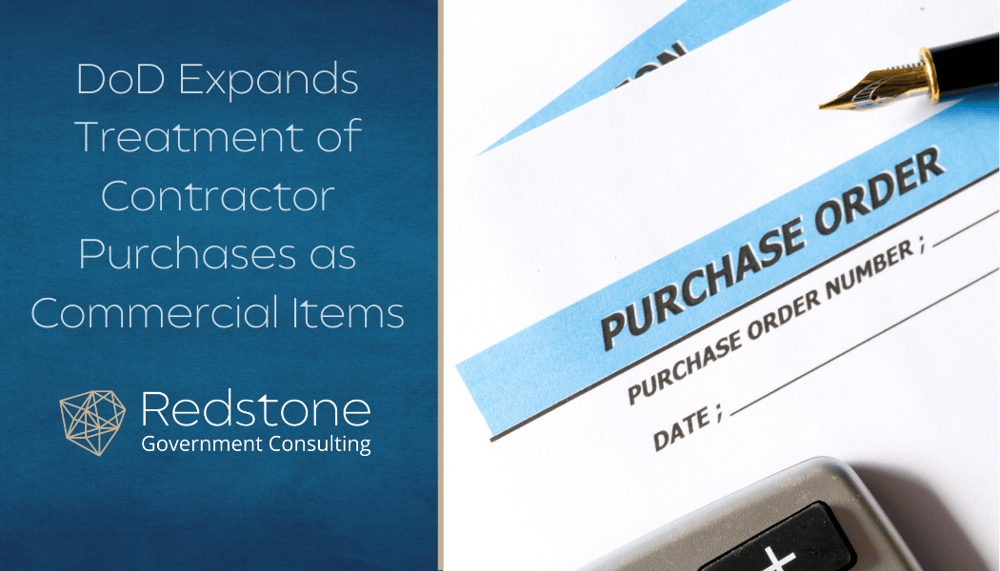
Here are the Details
DoD issued DFARs Final Rule D2019-D029 – Treatment of Commingled Items Under $10K, effective October 1, 2020, to implement several sections of the National Defense Authorization Act for Fiscal Year 2017 that addresses treatment of commingled items purchased by contractors and services provided by nontraditional defense contractors as commercial items. This blog only addresses the DFARS change relative to the treatment of commingled items purchased by a contractor. The final rule is applicable to all solicitations and contracts, including solicitations and contracts using FAR Part 12 procedures for the acquisition of commercial items and solicitations and contracts valued at or below the simplified acquisition threshold.
What Changed
DoD has amended the DFARS regulations to address the common situation in which a contractor who purchases items in bulk, intending to use the items for its general business, as distinguished from a specific subcontract, identifiable at the time of purchase with a prime contract.
There were three changes to DFARS 244.402 Policy Requirements and DFARS 252.244.7000 Subcontracts for Commercial Items.
First, DFARs 244.402 (S-70) was revised to state Contractors “are required to” determine whether a particular subcontract item meets the definition of a commercial item. Previously the wording was Contractors “shall” determine whether a particular subcontract item meets the definition of a commercial item. Contractors expressed concerns about the wording change from “shall” determine to “are required to” determine. DoD responded to this concern by saying that DFARS 244.402(a) does not tell the contractor that it shall do something but informs the contracting officer of a requirement applicable to contractors. By making this a policy requirement in DFARs 244.402 for the contractor officer with subcontracts for commercial items, it does become a requirement for the contractor. We must throw the BS flag on that. DCAA already believes numerous policy statements out of actual contract clauses (FAR 52 & DFARS 252) are iron clad requirements for contractors.
The second change was a new section added to DFARS 244.402 and DFARS 252.244-7000 Subcontracts for Commercial Items. The change was made to allow contractors to purchase items that are priced less than $10,000 per item (i.e., unit price) to treat it as a commercial item as long as the purchase was not identifiable to a specific contract at the time of purchase. The language is unclear as to whether the change is less than $10,000 per item or $10,000 per unit price. We believe the amount is related to the unit price not the total purchase of the item. The intent was to allow the contractor the benefit of treating these items as commercial items (i.e., fewer contract clauses to flow down and no CAS or Defective Pricing requirements on the subcontract). The items (when under $10,000 per item) do not have to meet the definition of a “commercial item” at FAR 2.101 nor does the contractor have to make a commercial item determination on the items. The final rule was established to address situations where a contractor purchases items in bulk versus specific to a contract.
Although this sounds like a deal, less administrative hassle of documenting commercial item determinations, most contractors do not purchase items in bulk to be held in inventory. There was concerns about commingling materials used on government contract with others. However, DoD indicates that there is no concern, the items treated as commercial items must comply with requirements applicable to commercial items needed to carry out the requirements of the prime contract (DFARS 252.244-7000), and did not excuse a contractor from compliance with requirements in FAR 52.244-6 and other agency supplements. The contractor is responsible for making sure when these items are assigned to a contract, that it meets all terms and conditions applicable to commercial items (FAR 52.244-6). We have concerns that the DCMA engineering and technical staff may not see it this way and have greater expectations.
Are there any Benefits
Although DoD thought this change would benefit contractors, are there advantages? When a contractor makes purchases and places them in inventory, the contractor is not reimbursed for the material until it is assigned to a contract. In addition, contractors want to reduce inventory carrying costs. One of the largest issues for contractors is the costs associated with carrying inventory, impact on cash flow. There are additional storage costs, personnel costs with inventory control and cycle counting, insurance costs associated with inventory levels and loss or misplaced items. Additionally, some states tax companies on year-end inventory values. The premise behind this was to encourage contractors to buy in bulk and reduce the administrative costs by using commercial item procedures. We simply do not believe the bulk buys will be an advantage, and in some cases could even be a risk to the contractor should DCMA technical, engineering or quality raise concerns about the inclusion of terms and conditions affecting their areas of responsibility.
Redstone GCI is available to assist contractor’s in assessing the most advantageous business decision related to purchasing under Government contracts. Redstone GCI assists contractors throughout the U.S. and internationally with understanding the Government’s expectations in applying FAR part 12 and 44.

